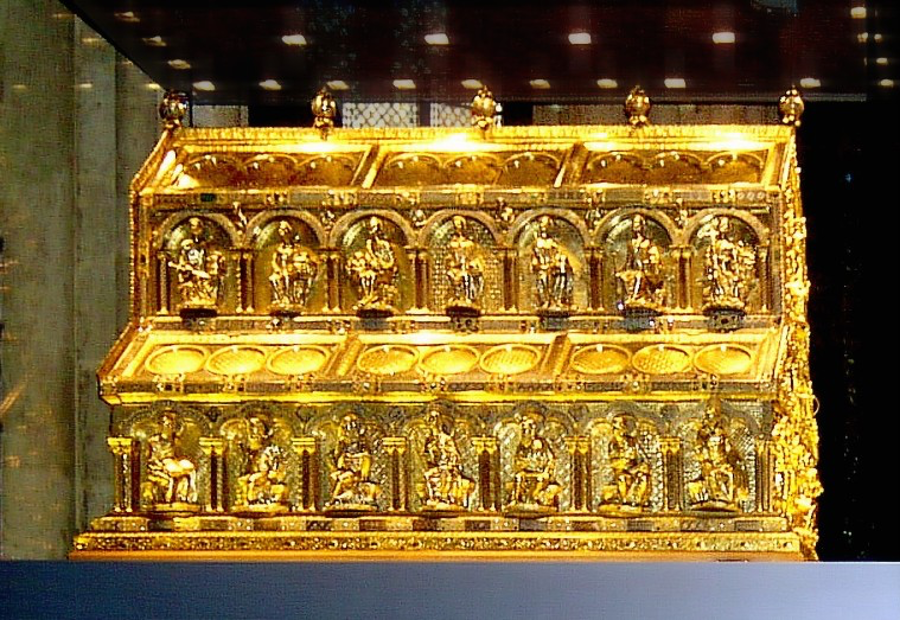Epiphany
Edward Burne-Jones. The Adoration of the Magi (silk, wool and cotton tapestry), 1904.
Musée d’Orsay, Paris.
[Burne-Jones designed the tapestry in 1888 and it was woven in 1894 by William Morris’s company, Morris & Co., at Merton Abbey Mills. Ten versions were made; the first was delivered to Exeter College Chapel, Oxford in 1890, and it is still there.]
(Listen to an audio version of the blog post above!)
This Sunday, January 2, 2022, marks the Feast of the Epiphany. In Matthew 2: 1-12 we read:
After Jesus was born in Bethlehem in Judea, during the time of King Herod, Magi from the east came to Jerusalem and asked, “Where is the one who has been born king of the Jews? We saw his star when it rose and have come to worship him.”
When King Herod heard this he was disturbed, and all Jerusalem with him. When he had called together all the people’s chief priests and teachers of the law, he asked them where the Messiah was to be born. “In Bethlehem in Judea,” they replied, “for this is what the prophet has written: ‘But you, Bethlehem, in the land of Judah, are by no means least among the rulers of Judah; for out of you will come a ruler who will shepherd my people Israel.’”
Then Herod called the Magi secretly and found out from them the exact time the star had appeared. He sent them to Bethlehem and said, “Go and search carefully for the child. As soon as you find him, report to me, so that I too may go and worship him.”
After they had heard the king, they went on their way, and the star they had seen when it rose went ahead of them until it stopped over the place where the child was. When they saw the star, they were overjoyed. On coming to the house, they saw the child with his mother Mary, and they bowed down and worshiped him. Then they opened their treasures and presented him with gifts of gold, frankincense and myrrh. And having been warned in a dream not to go back to Herod, they returned to their country by another route.
Tradition holds that the coming of the Magi—wise men from Persia—to visit the infant Jesus in Bethlehem marks the recognition of the Messiah by the Gentile world, thus fulfilling the prophecy in Isaiah 49: 6—“It is too small a thing for you to be my servant to restore the tribes of Jacob and bring back those of Israel I have kept. I will also make you a light for the Gentiles that you may bring my salvation to the ends of the earth.” Later tradition further identifies the Magi as “kings,” fulfilling the prophecy of Isaiah 60: 3—“Nations will come to your light, and kings to the brightness of your dawn.”
Although we’re not told in the story how many wise men there were, tradition holds there were three, based upon the three gifts they presented: gold, frankincense and myrrh. Tradition also names the Magi: Melchoir, Caspar and Balthasar. The names first appear in a Greek manuscript written in Alexandria, Egypt around A.D. 500 and translated into Latin under the title, Excerpta Latina Barbari.
Tradition goes on to say that Saint Helena, mother of Constantine, discovered the bones of the Magi on her famous pilgrimage to Palestine (A.D. 326-328), and that upon her return to Constantinople she deposited them at the great church of Hagia Sophia. Later the bones were moved to Milan. In A.D. 1158 the remains of three bodies—said to be the Magi—were found in the Church of St. Estergio. Emperor Frederick Barbarosa captured Milan in A.D. 1164 and moved the remains to Cologne. Chaucer, in his “Prologue” to the Canterbury Tales, tells us that the Wife of Bath visited the “three kings” in Cologne on one of her many pilgrimages:
And thries hadde she been at Jerusalem;
She hadde passed many a strange strem;
At rome she hadde been, and at boloigne,
In galice at seint-jame, and at coloigne.
(ll. 463-466)
Today, the bones of the “three kings” are still said to rest at the magnificent Gothic cathedral of Hohe Domkirche St. Peter und Maria in Cologne. The Shrine of the Three Kings is a gilded sarcophagus dating from the 13th Century, the largest reliquary in the Western world. The shrine was opened in 1864, revealing the remains of three men, along with 2,000-year old clothing.
Shrine of the Three Kings, Cologne
Epiphany marks the close of the Christmas season. Traditionally celebrated on January 6th, twelve days after Christmas, Epiphany is today celebrated in many churches on the Sunday following January 6th, although in the Roman Catholic Church in the United States it is celebrated on the Sunday between January 2nd and 8th. The traditional twelve days of Christmas comprise: Christmas itself, on December 25; St. Stephen’s Day (or Boxing Day) on December 26 (In the United Kingdom, on the first weekday after Christmas, gifts are “boxed” and given to service workers; hence, “boxing day.”); Feast of the Innocents (or “Childermas”) on December 28; and Twelfth Night on the eve of Epiphany (The Feast was made famous by William Shakespeare when he set his play, “Twelfth Night,” on this date.). The entire sequence spanning December 25-January 6 is known as “Christmastide.”
In popular culture the “Twelve Days of Christmas” are memorialized in song. A popular folk song, probably of French origin, “The Twelve Days of Christmas” was published as a poem in England in 1780 in the children’s book “Mirth without Mischief.” James O. Halliwell added music to the poem in the 4th edition of his “The Nursery Rhymes of England,” in 1846. The song enumerates a series of increasingly extravagant gifts on each of the twelve days of Christmas:
Day 1 A Partridge in a Pear Tree
Day 2 Two Turtle Doves
Day 3 Three French Hens
Day 4 Four Calling Birds
Day 5 Five Gold Rings
Day 6 Six Geese A-laying
Day 7 Seven Swans A-swimming
Day 8 Eight Maids A-milking
Day 9 Nine Ladies Dancing
Day 10 Ten Lords A-leaping
Day 11 Eleven Pipers Piping
Day 12 Twelve Drummers Drumming
Extravagant in its day, “The PNC Annual Christmas Price Index” calculates that giving such gifts today (2021) would cost $179,454!
The Church has a rich and colorful history that reflects all the joys and difficulties of living a life in Christ in community. The Twelve Days of Christmas—Christmas through Epiphany—is a joyful highlight of our rich family heritage.
Listen to “The Twelve Days of Christmas”…


